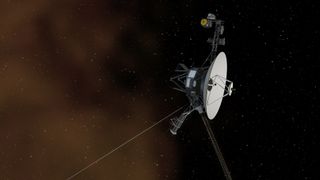News
Science & Astronomy

An artist’s depiction of a Voyager probe entering interstellar space.
(Image credit: NASA/JPL-Caltech)
Voyager 2 is still broadcasting a “heartbeat” from deep space after a communications breakdown.
NASA’s long-running Voyager 2 mission, which launched from Earth in 1977, automatically sent a “carrier signal” picked up by the agency’s Deep Space Network, agency officials stated Monday (Aug. 1).
“A bit like hearing the spacecraft’s ‘heartbeat,’ it confirms the spacecraft is still broadcasting, which engineers expected,” officials with NASA’s Jet Propulsion Laboratory (JPL) stated on Twitter. Canberra, Australia’s DSN Twitter account confirmed the news as well.
JPL will next send a command to Voyager 2 asking the spacecraft to point itself to Earth. “If that does not work, we’ll have to wait until October, when the spacecraft’s onboard software automatically tells it to reset its direction,” the statement added.
Related: NASA Voyager 2 spacecraft extends its interstellar science mission for 3 more years
The spacecraft, which is about 12.4 billion miles (19.9 billion kilometers) from Earth, lost contact with our planet after a set of commands accidentally moved Voyager 2’s antenna two degrees away from Earth.
The mistake severed the link to the ground antennas of the DSN, stopping Voyager 2 from sending back data in interstellar space. Engineers also have, so far, not been able to send commands to the spacecraft. But Voyager 2’s programming already has backup enabled, as the spacecraft automatically resets its orientation a few times a year in case of troubles like this.

A diagram showing NASA’s Voyager 2 spacecraft entering interstellar space in November 2018. (Image credit: NASA /JPL-Caltech)
Voyager 2 flew to space from Launch Complex 41 at Cape Canaveral, Florida, on August 20, 1977. After swinging by the four gas giant planets of the solar system between the 1970s and 1990s, it entered interstellar space on Dec. 10, 2018.
Its twin craft Voyager 1 is also operational, flying far away at about 15 billion miles (24 billion km) from Earth. It was the first object to move beyond the gravitational influence of our star, the sun, in 2012.
The missions are slowly losing power from their nuclear radioisotope generators, but engineers have made several alterations to preserve their systems where possible. The heaters have been shut off, for example, and in April 2023 engineers disabled Voyager 2’s surge protector (or voltage regulator).
These steps remove a bit of backup for the spacecraft while allowing their power supplies to last longer. The 2023 step alone has postponed one of the instrument shutdowns for Voyager 2 by three years, extending space data collection until at least 2026, officials said at the time.
Join our Space Forums to keep talking space on the latest missions, night sky and more! And if you have a news tip, correction or comment, let us know at: [email protected].
Breaking space news, the latest updates on rocket launches, skywatching events and more!
Elizabeth Howell (she/her), Ph.D., is a staff writer in the spaceflight channel since 2022 covering diversity, education and gaming as well. She was contributing writer for Space.com for 10 years before joining full-time. Elizabeth’s reporting includes multiple exclusives with the White House and Office of the Vice-President of the United States, an exclusive conversation with aspiring space tourist (and NSYNC bassist) Lance Bass, speaking several times with the International Space Station, witnessing five human spaceflight launches on two continents, working inside a spacesuit, and participating in a simulated Mars mission. Her latest book, “Why Am I Taller?”, is co-written with astronaut Dave Williams. Elizabeth holds a Ph.D. and M.Sc. in Space Studies from the University of North Dakota, a Bachelor of Journalism from Canada’s Carleton University and a Bachelor of History from Canada’s Athabasca University. Elizabeth is also a post-secondary instructor in communications and science at several institutions since 2015; her experience includes developing and teaching an astronomy course at Canada’s Algonquin College (with Indigenous content as well) to more than 1,000 students since 2020. Elizabeth first got interested in space after watching the movie Apollo 13 in 1996, and still wants to be an astronaut someday. Mastodon: https://qoto.org/@howellspace
>>> Read full article>>>
Copyright for syndicated content belongs to the linked Source : Space.com – https://www.space.com/voyager-2-heartbeat-earth-deep-space-signal































